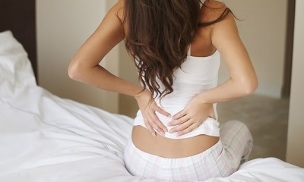
Low back pain is a symptom that may be related to various medical conditions. They can be permanent or periodic, partial or generalized.
If a person has pain in the lumbar spine, a thorough examination is needed to determine the cause.
Possible causes and characteristics of low back pain
Low back pain can be caused by many reasons, depending on the severity of the discomfort. Pain syndrome reduces people’s quality of life, limits their ability to move, and makes them unable to perform daily tasks.
There are many causes of back pain in the waist area. Some of them are very serious and require immediate expert intervention.
Sciatica
Sciatica is a disease of the musculoskeletal system in which the root of the spine is compressed and inflamed. This pathology is secondary because it develops in the context of the degenerative process of the musculoskeletal system.
The common symptoms in this situation are:
- Pain syndrome, increased sudden movements and increased weight lifting. The locality of the pain depends on the extent of the injury. The syndrome can affect the waist and hip areas at the back or front of the thighs. If the nerve endings below the first and second lumbar discs are damaged, the patient has low back pain in the waist and buttocks.
- The severity of pain increases when coughing or sneezing.
- cannot stay in one position for a long time.
- Mobility disorder: unable to tilt the torso forward, backward or sideways freely, unable to bend the fingers of the lower limbs.
With lumbar radiculitis, the pain usually appears suddenly and stops spontaneously. The pain will become more severe next time.
Osteoporosis
Osteoporosis of the spine is a phenomenon in which calcium leaches from bones and disrupts the activity of cells responsible for bone growth. In this case, the bones are rapidly destroyed and the density continues to decrease. Osteoporosis is difficult to suspect in the early stages of development.
The most common situation is that patients feel severe pain in the waist area when they are intensely nervous-the body turns sharply, falls, and lifts weights.
In addition to severe lower back pain, osteoporosis also has the following manifestations:
- Chronic fatigue;
- Abdominal bulge;
- Impaired the mobility of the spine.
In compression fractures caused by osteoporosis of the lumbar spine, acute pain may occur, which is aggravated by touching the affected area and muscle spasm.
Scoliosis
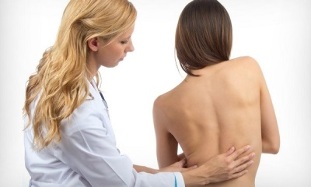
When the lumbar spine is bent, its structure is skewed to the right or left. These changes are reflected in the state of the surrounding tissues: they are irritated, and inflammatory foci appear in the muscular ligament structure.
is most often diagnosed as left scoliosis. In left-handed people, scoliosis develops on the right side.
In the initial stage, lumbar scoliosis may not appear in any way. Negative changes can only be tracked through X-ray inspection results.
In addition to severe lumbar pain, the characteristic symptoms in this case include:
- Lazy
- Swollen waist;
- The blade diverges.
The characteristics of lumbar scoliosis pain: it appears at the beginning of physical activities, and the discomfort during walking is reduced. The pain is usually short-lived.
Damage
Waist contusion occurred during a fall and during a hit. The lumbar area is most vulnerable to trauma.
Lumbar contusion is a closed injury to tissues and part of the spine, and does not cause anatomical abnormalities. Usually, this kind of injury occurs among athletes and people in the workplace.
When injured, the following other symptoms are also observed:
- Formation of hematoma;
- Redness of the skin;
- Pressing the injured area will increase the pain.
If the contusion is severe, it may interfere with the nerve impulse conduction in certain areas of the lumbar spine, and in some cases it will completely lose sensitivity.
The symptoms of waist injury are more obvious, including the following:
- Pain when probing the affected area.
- Growing hematoma;
- Pain when turning the body, unable to bend;
- Swelling of the ankle, indicating poor blood circulation;
- Paralysis and paralysis of the lower limbs.
Rheumatoid Arthritis
Spinal rheumatoid arthritis is another possible cause of low back pain. In this case, the joints located in this area will be affected.
Rheumatoid arthritis pain occurs most often at night, usually closer to the morning. In the initial stage, special exercises can be used to suppress the syndrome, but at night, the pain will reappear.
Other symptoms: local temperature increase in the affected area, fluid accumulation in the affected joint cavity.
Osteochondrosis
Osteochondrosis is a pathological process in which the intervertebral disc loses elasticity. As the disease progresses, cracks form and hernias form.
In the initial stage of osteochondrosis, lower back pain rarely occurs and there is no difference in intensity. In the future, they will have obvious chronic characteristics. The patient felt stiff in exercise and continued fatigue. Difficulty bending and stretching the back.
Pain often spreads to the lower limbs. Simultaneous tingling and numbness.
With the increase of physical activity, sudden exercise, weightlifting, the intensity of unpleasant feelings will increase.
Malignant tumor
If the back is injured in the waist area, it may be related to dangerous pathologies such as cancer. In this case, the malignant tumor does not necessarily affect the bone structure of the spine. In this case, the pancreas behind the stomach may be affected, so the lower back may feel pain. Severe pain indicates an advanced stage of cancer.
In addition, the pain in the waist area may be related to the tumors of other organs that have spread to the designated area.
In women, spastic low back pain may be a sign of ovarian cancer. In men, severe and prolonged cramps herald prostate tumors.
Gynecological diseases
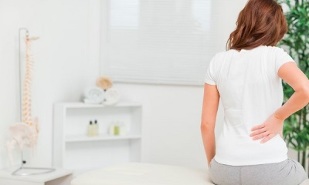
Women often worry about lower back pain. In such as
Under the influence of such pathology, similar symptoms may appear.- Rupture of ovarian tissue;
- The pathological process of the uterus;
- Ovarian cyst;
- Cervical cancer;
- The inflammatory process of the fallopian tube; The benign tissue on the lining of the uterus.
Low back pain usually occurs in women whose pregnancy has been artificially terminated. The discomfort is caused by the mechanical damage of the uterine tissue and the prolonged process of wound tightening.
Women suffering from gynecological diseases have lower back pain, pulling, soreness. In addition, it violated the menstrual cycle, decreased intensity, irritable, and increased body temperature. Usually, the pain syndrome is supplemented by the various consistency and color secreted by the vagina.
In this case, the pain syndrome is caused by hormonal imbalance and the spread of inflammatory processes to the tissues of the waist area.
Kidney disease
Waistband pain is a sure sign of kidney disease.
Similar symptoms are accompanied by the following pathologies, for example:
- Urolithiasis;
- Pyelonephritis;
- Glomerulonephritis;
- Nephropathy (kidney prolapse).
In the case of stones in the urinary tract, the pain in the waist area is not obvious, and it is dull. For inflammatory processes involving the kidneys, the pain will continue. In this case, its positioning is on the left and right sides of the spine.
Acute pain means renal colic. The pain spreads to the groin area, inner thigh, and anterior abdominal wall.
Other signs that may indicate kidney disease include:
- Increased blood pressure;
- The swelling of arms, legs, and face that appeared after waking up, disappeared during the day;
- Changes in urination: the process may be quick and painful, or on the contrary, it is rare, until it stops completely;
- lethargy;
- Increased sweating;
- Loss of appetite.
Lower back discomfort and pain are usually related to the pressure of the fetus on the pregnant woman’s kidneys. In this case, the pain syndrome is not related to any pathology, which is a completely natural phenomenon.
Male genitourinary system diseases
In people with strong sexual ability, genitourinary diseases often cause lower back pain. In most cases, the discomfort is caused by prostatitis-the prostatitis process. With this disease, the process of urination and sexual function is disturbed. In addition to lower back pain, there is also traction pain in the lower abdomen.
Another male disease that causes waist pain is epididymitis, epididymitis.Psoasitis
Lumbar myositis is an inflammatory process of muscle tissue, manifested by muscle pain and weakness, and sometimes even atrophy. The disease can be caused by infection process, trauma, hypothermia, and abnormal metabolism in the body.
This pathological feature is:
- Lower back pain, which worsens with exercise;
- The feeling of muscle weakness;
- Swelling and redness of the skin.
Bone tuberculosis
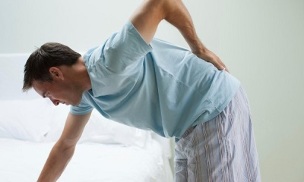
Because of spinal tuberculosis, the lower back is often painful. In this case, the nature of the pain syndrome depends on how many vertebrae are involved in the pathological process and the degree of structural deformation.
The main symptoms of spinal tuberculosis are:
- Severe pain in the waist area. This positioning is related to the fact that the waist area is the largest part of the spine and bears the greatest load.
- Increased sweating at night.
- Swollen lymph nodes.
- The temperature rise is within 37. 1-37. 3 degrees.
- Constant fatigue.
As spinal tuberculosis progresses, this structure has an angular curvature, and abscesses develop in the lumbar and thoracic spine areas.
Orgasm
In the context of hormonal changes, the entire musculoskeletal system becomes fragile: intervertebral cartilage and discs become weak, muscles and ligaments lose elasticity. As a result, the area of the lumbar spine, which is always subjected to the greatest pressure, is particularly at risk.
In addition to lower back pain, menopausal women also suffer from headaches, excessive sweating, and hot flashes.
Vascular Pathology
Abnormal blood circulation caused by pathological vascular processes can also cause pain in the lumbar region. Thrombophlebitis, atherosclerosis, and venous thrombosis lead to the onset of pain syndrome.
Blood clots in the veins, inflammation of the vessel walls, narrowing of the vascular lumen-all of which hinder the full flow of blood, thereby restricting the oxygen supply to human tissues and structures, which negatively affects its condition.
Other symptoms that accompany vascular disease include swollen veins, heavy limbs and blue skin.
Enteropathy
For intestinal diseases, the pain may radiate to the lower back. This is due to the fact that the intestine occupies a large space in the abdominal cavity. If any part of it undergoes pathological changes, it will grow and cause pressure on other organs. The spine is also dangerous.
Ulcerative colitis, exacerbation of appendicitis, intestinal obstruction, irritable bowel syndrome pain extends to the waist.
If the pathological process spreads to the stomach, the pain is located in the upper part of the lower back. If harmful products are abused, they will appear after a meal and be hungry.
The following symptoms were observed in parallel:
- Flatulence;
- Fecal diseases;
- Abdominal pain.
Obesity
Being overweight can put extra pressure on the spine (especially the lumbar spine). Constant pressure leads to the risk of musculoskeletal system diseases, which can cause disc damage, spinal curvature and the development of osteochondrosis.
In addition to the above-mentioned pathological reasons, long-term driving or computer use, excessive burden on the gym, summer homework hobby, and sedentary lifestyle may cause waist pain.
Which doctor should I go to?
The appearance of lower back pain is usually caused by a serious disorder of the body, so it is important to consult a doctor in time to diagnose the real cause and treat it.
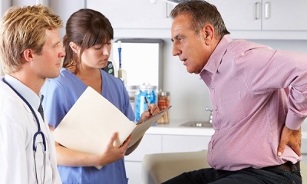
If the patient has pain in the waist area, it is necessary to consult an expert:
- is regular;
- keeps appearing after physical effort.
- will not disappear when lying down;
- Accompanied by numbness of the limbs and increased body temperature.
If you have lower back pain, the main specialist you should contact is:
- vertebral orthopedist (treatment of osteochondrosis and other neurological diseases);
- Neurologist;
- Nephrologist (urologist): This specialist diagnoses and treats whether lower back pain is related to the pathological process of the genitourinary system.
If necessary, other experts will be involved in the diagnosis and treatment process: orthopedic doctors, surgeons, gynecologists, oncologists and gastroenterologists.
Diagnosis
For pain in the waist area, the following diagnostic measures are prescribed:
- Routine inspections, recall records;
- Test to determine constrained nerve endings;
- Blood test to assess hemoglobin level;
- Myelography;
- X-ray examination of the spine;
- MRI;
- CT; Ultrasound examination of abdominal organs;
- Endoscopy of uterus, stomach and intestines;
- Bone scintillation scan.
The activities listed can summarize a complete picture of the patient’s condition, determine the disease causing lumbar pain, and determine the appropriate treatment plan.
Treatment of low back pain
The main treatment for low back pain depends on the cause of the symptoms. Treatment aims to eliminate existing diseases.
General principles
Processing is based on the following:
- Use drugs to inhibit the inflammatory process;
- Perform physical therapy procedures designed to accelerate the recovery of affected structures;
- Physical therapy exercises.
During the treatment process, the patient must avoid active physical activities and any physical activity to avoid aggravating the pathological process. During the recovery period, patients are advised to practice yoga, swimming and hiking in fresh air.
The therapy also includes dietary adjustments. The patient should reject all fatty and fried heavy foods. It is important to give up bad habits-this will greatly speed up the healing process.
Medicines

For pain in the waist area, medications are usually prescribed in the form of injections, including vitamin B. The tasks of these drugs are:
- Speed up the recovery of damaged nerve fibers;
- Increase the functional activities of the central and peripheral nervous system;
- Speed up the metabolic process.
For severe, severe lower back pain, strong painkillers are needed.
Non-steroidal anti-inflammatory drugs that control injection inflammation can also be administered by injection.
During the injection of non-steroidal anti-inflammatory drugs, this group of drugs is administered orally in the form of tablets.
For muscle cramps that cause lower back pain, medications such as muscle relaxants should be prescribed.
also prescribed topical drugs for patients. They usually have a warmth and help suppress pain. They are only prescribed as part of a comprehensive treatment.
For pain in the waist area, a special ointment is recommended.
Remedial gymnastics
A set of therapeutic exercises is prescribed only after the pain syndrome is relieved. During the worsening period, therapeutic exercises are prohibited.
For waist pain, the following exercises are recommended:
- Elevate the pelvic area. You need to lie on your back and bend your legs at a right angle. The pelvis should be lifted slightly and returned to its original position. Repeat 10-15 times.
- Keep your balance.The exercise is carried out in a standing position. You need to stand up and try to maintain your balance in this position for about 10-15 seconds. Repeat 3-5 times.
- Lift your legs from the prone position.Lie on your back and alternately raise your straight lower limbs to make them as high as possible. Perform 5-10 lifts on each leg.
- hip exercises.You need to sit on the floor and straighten your back. Use the pelvis and hips to move forward and then backward. You need to walk about 2 m forward in this way and the same distance backward. The number of entries is 2-3.
You cannot do gymnastics with spinal injuries, tumors and hernias, and acute illnesses.
Physical Therapy
Perform physical therapy, provided that the lower back pain is not caused by an acute inflammatory process. Acute pain syndrome is initially relieved by conservative methods and can only be relieved after physical therapy is prescribed.
For pain in the waist area, the following steps are prescribed:
- Magnetic therapy.This method can improve blood circulation in the affected area.
- Electrophoresis.If you want to speed up the delivery of drugs to the lesion (analgesics, non-steroidal anti-inflammatory drugs, chondroprotective agents), you must use this method.
- Laser therapy.This technology allows you to normalize your metabolism and improve blood circulation in the affected area.
Nutrition
To strengthen the bones, you should add cheese, dairy products and whole milk, fatty sea fish and brown bread to your diet.
If the patient is overweight, which will increase the burden on the spine, flour, candies and sugary carbonated drinks must be excluded from the diet.
Folk remedies
Traditional treatment methods should never be the basis for the treatment of low back pain. They are only auxiliary methods and are only used with the approval of the attending doctor.
For low back pain, you can use the following traditional medicine recipes:
- Honey ointment.To prepare a medicinal composition, you need to take 3 tablespoons of natural bee honey and then melt it in a water bath. Cool the composition. Add 2 tablespoons of pharmacy alcohol to the honey, then add 100 grams of petroleum jelly, and rub it into the local painful area. For greater effect, you can apply a compress in this ointment. In this case, it will not rub on the skin, but spread it on the skin in a thin layer with plastic wrap, and then wrap it in a warm scarf. Leave the dressing for 3-4 hours, then wash off the composition with warm water.
- Salt compression.It is necessary to dissolve table salt in hot water (ratio-1: 10) and stir. In the finished solution, moisten several layers of folded gauze, cover the lower back with a compress, wrap it in a towel, and heat it with a scarf. Leave it overnight and remove the remaining compress in the morning.
- Garlic compression.You need to take 3 heads of garlic, peel and chop them. Pour the resulting substance into warm water (2 cups) and let it stand for 3 hours. During the infusion, wet the cotton cloth and sprinkle freshly squeezed lemon juice on the entire surface. Apply cold compresses. Let stand for 20 minutes to allow the wet towel to reach body temperature. After that, the compression procedure is repeated. This can be repeated until the patient feels relieved.
- Use body compression.You need to mix bodyagi powder and olive oil in a ratio of 1: 30. Use the obtained composition to lubricate the sore lower back and allow the product to stay on the skin for 40 minutes. After the specified period expires, the product must be rinsed with warm water.
- Compressed material of dried beef leaves.You need to moisten the raw material in boiling water, apply it on the back, and wrap it in a warm scarf. Leave on for at least one hour.
- Baths containing additives.Taking a bath can reduce the severity of the pain. As additives, 200 grams of mustard powder and 600 milliliters of broth on mint leaves can be used. Take a shower in 20 minutes. The water should be warm.

All the treatments listed are aimed at reducing back pain, that is, symptomatic.
The treatment of specific diagnosed diseases should be carried out in a separate plan.
Prevention
To reduce the risk of lower back pain, you should:
- Monitor your posture;
- can only stand and walk in a straight posture;
- Perform special exercises to strengthen the spine and back muscles;
- Don't put too much load on the spine, do exercises that use back muscles moderately;
- Avoid hypothermia;
- Do as much as possible an exercise that will not negatively affect the spine: swimming, yoga, and walking are particularly useful;
- Don't move suddenly when lifting the load;
- Sleep on a medium firm mattress, the most important thing is-orthopedics, pillows should also be orthopedics, and medium size;
- Track weight, if necessary, diet and perform special exercises to combat excess weight;
- Take vitamin and mineral complexes, especially during periods of hormonal changes in the body.
Back pain is not only related to spinal diseases, but also to internal organ dysfunction. Experts can determine the true cause of the pain syndrome during diagnostic measures. Both the symptoms themselves and their causes should be treated.

























